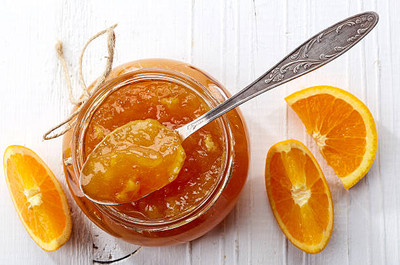It’s marmalade making time again!
Posted by The Wares Team on 23rd Feb 2021
Beloved staple of the British breakfast table. Favourite food of a mild mannered Peruvian bear. There’s something special about marmalade. Homemade marmalade recently replaced banana and sourdough bread as the latest lockdown food trend. Let’s celebrate its cult following, strong traditions and chic street cred.
Marmalade wasn’t always stored and served in recycled jam jars
It’s true. 'Marmalade' comes from the Portuguese word 'Marmelada', the name of the quince preserve introduced to the UK in the 15th century. In those days (and for a couple hundred more years), marmalade was a dark, set confection, sliced and eaten solo.
The first hint of modern marmalade appeared in the 18th century. Dark thick sweetmeat was replaced with translucent jelly sprinkled with delicate slices of peel. Experts believe the Scottish added more water to their marmalade recipes to make the preserve more spreadable. The rest is much haggled history.
Marmalade blends citrus juice, slivers of citrus peel, water and sugar. Seville orange is the traditional favourite. Contemporary recipes yield around eight marmalade jars worth of beautiful tangy marmalade. Stored away from direct sources of sunlight and heat, your marmalade will keep for a year. After opening, store in the fridge and use within three months.
Recycle your jam jars and enter the Marmalade Awards!
The Marmalade Awards were conceived by Jane Hassell-McCosh in 2005. The purpose of the awards is to celebrate and protect the ritual of marmalade making and raise money for charity. To date the Marmalade Awards have raised over £250,000 for Hospice at Home.
The annual Marmalade Awards are held at magnificent Dalemain Mansion in Cumbria. This oft visited stately ancestral home also features a treasure trove of ancient marmalade recipes, including one from the 17th century. Three main categories are featured at the annual Marmalade Awards: Homemade Awards, Artisan Awards and Hotel, Restaurant and B&B Awards.
Wares of Knutsford is a proud sponsor of the Marmalade Awards. We assist by distributing entry forms and displaying our glassware and preserving materials at the awards every year. Around 3,000 glass jars of marmalade are entered to be judged at the Marmalade Awards. Homemade offerings are sent from over 40 countries including Japan, Lebanon, Australia, India, Czech Republic, Brazil, Colombia and Canada.
Upcycled jam jars filled with homemade marmalade stealing hearts
The Homemade Marmalade Awards features 14 categories, including a brand new category 'Marmalade for a friend'. Jane Hassell-McCosh’s created the category inspired by obstacles overcome throughout the pandemic. Entrants dedicate their homemade marmalade to someone special. The stories and messages attached to marmalade jars and jam jars bursting with homemade marmalade are heart-warming.
The winner of the Homemade Awards category also wins the extraordinary experience of their marmalade commercially produced by bespoke producers Thursday Cottage and sold at Fortum and Mason’s legendary Piccadilly location, and online. For the first time ever, an international shelf: K11 Atelier in Hong Kong.
'Heart’s Pursuit' and jam jars around the world compete for prizes
The 2021 Marmalade Awards is going ahead! Logistics feature pandemic related tweaks, such as winners announced at the annual Dalemain Plant Fair on 20 June, instead of the annual Marmalade Festival in March. However, there will be virtual videos celebrating National Marmalade Day on 13 March, to keep everyone going until June.
Another quirky tradition is the number of men throughout history making their own marmalade. To honour their contribution, here’s a sumptuous Sticky Marmalade Pudding recipe from Nigel Slater. Serves six lucky guests.
You will need 195g dried vine fruits, 80ml brandy or marsala, 120ml boiling water, 75g butter, 100g soft brown sugar, 1 large egg lightly beaten, 180g self-raising flour and 50g walnut halves. For the sauce, set aside 125g soft brown sugar, 150ml double cream, 50g butter, 150g marmalade and a pinch of salt.
Lightly grease a deep dish measuring around 22cm x 15cm. Add your vine fruits to a heat resistant mixing bowl, then pour the boiling water and marsala. Infuse for 20 minutes. Switch oven on to 180C/gas mark 4.
If you have a food processor handy, add the butter and cream. You’re looking for a soft, creamy consistency. Add the lightly beaten egg and blend until the consistency is lovely and smooth. Add self-raising flour, infused vine fruits and all the liquid. Use the back of a large steel spoon or the end or your trusty rolling pin to lightly crush your walnut halves, then add those too.
Move the mixture from the mixing bowl to your lightly greased dish. Smooth it out. Pop inside the oven and bake for around 35 minutes. You’re looking for golden sponge with a slightly firm texture.
While your dreamy sponge is baking, turn your attention to the gorgeous sauce. Add ingredients to a saucepan until they begin to boil. Remove from the heat as soon as the butter melts.
Slather the sauce over the top of the golden sponge, return to the oven for around seven minutes. Serve hot with a dollop of fresh cream.

